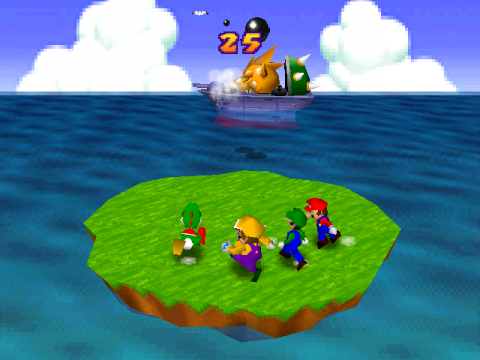
Gamers always claim that original trilogy of Mario Party games are the highest point of the series, and it’s not hard to see why. After roughly a dozen iterations of the same game, the once innovative party series has either run itself dry with very similar iterations or failed to reinvent the wheel in a way that most people would enjoy. The negative reviews of both recent titles in the series, Mario Party 9 and Mario Party: Island Tour, exemplify this point of view and aptly show the critical reception that the series currently retains.
Yet, back in 1999, Mario Party was a concept that was new to Nintendo fans. The game is essentially a board game within a video game where players must roll dice, traverse unique boards, and collect coins to purchase stars at specific spaces. To win the game, players would have to collect more stars than their competitors. In order to make a board game suitable for an interactive medium, developer Hudson Soft included 50 minigames to offer a little variety that would supplement the core gameplay after each turn. While the board game element is interesting in its own right, the minigames stole the show as the game’s best feature. Sure, Mario could be considered a sadist for hosting minigames like Bombs Away at his party, since all players need to survive an onslaught of cannon fodder on a small island to win, but there’s no doubt that these games were an awesome distraction nonetheless!

Even though the concept was fresh at the time, the game is not without its flaws. A huge problem with the original Mario Party is its focus on rotating the control stick in certain minigames. Since the object of these minigames is to spin the control stick as fast as possible, many people injured the palms of their hands as a result. This got bad enough to the point where Nintendo had to release Mario Party gloves to prevent injury! The board game section is also lacking, as there was not much to do other than choose a direction or roll a dice. Because of this, I only looked forward to the minigames, which thankfully happened quite frequently. However, being one of the first of its kind, the original Mario Party still deserves praise for what it accomplished for its time.
Naturally, all of the problems with the original were fully addressed in Mario Party 2. For starters, Hudson Soft got rid of the control stick spinning mechanic. Instead, the studio remade some of the more successful minigames from the original and added new ones as well, leading to a total of 65 minigames. There were also new types of minigames as well, such as battles and duels, that made competing players wager a certain amount of coins. Winning a battle or a duel could drastically alter the current rankings, as a lot of coins tend to be at stake in these minigames. Hudson Soft also added collectable items, which made the board game aspect a lot more interesting to play because it added an element of strategy to the mix. These items ranged from small helpful items, like a mushroom that added extra dice blocks to a single roll, to ones that could completely change the outcome of the game, such as the magic lamp that automatically brought you to the star. All of the refinements that Mario Party 2 made to the existing formula helped set it as one of the best games in the entire series.

Due to the massive success of the first two games, Hudson Soft went on to release Mario Party 3 as its last entry on N64. This title had a selection of 70 entirely new minigames, which is the biggest amount in the whole N64 trilogy. Mario Party 3 also placed a heavier emphasis on items, which effectively made the board game section better than ever. In Mario Party 2, you could only carry one item at a time, but you could carry up to three in Mario Party 3! Plus, all of the items are a lot less expensive, making them easier to buy and carry for future use. The game even had a new two player mode, called Duel Mode, in which players battled each other in an RPG fashion with party members like Chain Chomp and Bob-omb. Everything I loved from Mario Party 2 was greatly enhanced with more refinement and new features, making this my favorite Mario Party game to date.
The fact that so many iterations of Mario Party exist is only a testament to the series’ success. To me, these games are still the perfect multiplayer experience for four players, and are very easy to play for newcomers and veterans alike. Do you have fond memories of competing with your friends in Mario Party? Sound off in the comments below!




 ShareThis
ShareThis






